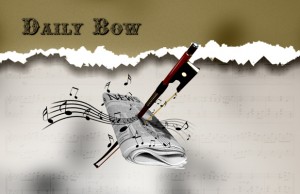Musicians of chamber group Wild Up become exhibition at the Hammer in Los Angeles
The world of the concert hall and the art museum share many similarities. Our modern symphony orchestra is actually a type of museum, in effect, for musical masterworks. This is no accident; musicians of the nineteenth century actually encouraged the establishment of ensembles expressly designed to reprise works of the past in order to keep them alive. Before this, the practice was to perform mostly new compositions, relying on living composers rather than revering the old ones. In this way, art museums and symphony orchestras serve a similar purpose: they preserve artistic masterworks for posterity in a public venue where, for a price, the world can come and see them.
Modern art, however, isn’t all about preserving masterworks. Especially in the last decade, visual art has become as much about the process of creating a works as it is about the final product. Could this concept translate to music as well? The Hammer Museum, in Los Angeles, is showing us how. In collaboration with the modern music collective Wild Up, the Hammer has created an exhibition that puts the group on display. The rehearsals are completely open, and the concerts are unlike anything most have ever experienced; eclectic programs are known to combine Schoenberg, punk rock, computer music, and LaMonte Young in a single night.
Wild Up, which is directed by the young conductor Christopher Rountree, is now in the middle of a six month residency at the Hammer. The project was designed to enhance the connections between visual art and music. All of the groups’ three dozen or so performances are free, as well as their open rehearsals, which reveal the construction of every concert to the audience. The group sees what it does as process-oriented art. This starkly contrasts the standard symphony model, where musicians slave away in secret and present a few concerts every week, which the public is expected to come and observe, knowing in advance what will be presented to them. In this way, Wild Up’s residency at the Hammer builds a relationship with the public. Listeners can come in and watch a program come to life. Rountree and many of the musicians in the ensemble have, at one point, been in a rock group, and he says that is evident in the rehearsal process. Although this sometimes leads to conflict as the musicians are improvising or trying to iron-out some of the more theatrical parts of a given program, it ultimate involves the audience in the process of an artwork, making them more likely to come to the concert.
What is happening at the Hammer is a fascinating example of new directions in classical music. When you read about or listen to Wild Up, you can feel the energy of the group; their enthusiasm is contagious. Their programs and their idea of creating a performance as process-art is incredibly interesting, especially to younger audiences. The young generation can get into a classical group that’s not afraid to show how the music is made, and one that isn’t afraid to arrange a Katy Perry for early music instruments. Wild Up’s energy and versatility is exactly what classical music needs these days in addition to the venerated museums of symphony orchestras. I believe that can live side by side. Ultimately, they enrich each other just as modern art galleries coexist with big name art museums. The may serve different purposes, but they both exist to open up art to the people, just like Wild Up is doing.















No comments yet.